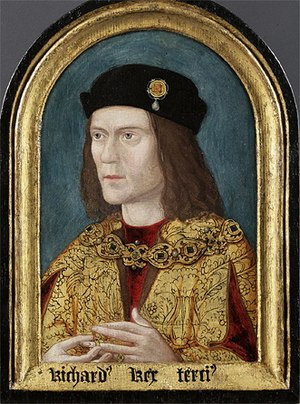Richard III of England
Relevance
Mentioned In
Wikipedia Information
 |
Richard III (2 October 1452 – 22 August 1485) was King of England from 26 June 1483 until his death in 1485. He was the last king of the Plantagenet dynasty and its cadet branch the House of York. His defeat and death at the Battle of Bosworth Field, the last decisive battle of the Wars of the Roses, marked the end of the Middle Ages in England. Richard was created Duke of Gloucester in 1461 after the accession of his brother Edward IV. In 1472, he married Anne Neville, daughter of Richard Neville, 16th Earl of Warwick and widow of Edward of Westminster, son of Henry VI. He governed northern England during Edward's reign, and played a role in the invasion of Scotland in 1482. When Edward IV died in April 1483, Richard was named Lord Protector of the realm for Edward's eldest son and successor, the 12-year-old Edward V. Before arrangements were complete for Edward V's coronation, scheduled for 22 June 1483, the marriage of his parents was declared bigamous and therefore invalid. Now officially illegitimate, Edward and his siblings were barred from inheriting the throne. On 25 June, an assembly of lords and commoners endorsed a declaration to this effect, and proclaimed Richard as the rightful king. He was crowned on 6 July 1483. Edward and his younger brother Richard of Shrewsbury, Duke of York, called the "Princes in the Tower", disappeared from the Tower of London around August 1483. Accusations were circulating that they had been murdered on King Richard's orders, even before the Tudor dynasty became the established rulers two years later.There were two major rebellions against Richard during his reign. In October 1483, an unsuccessful revolt was led by staunch allies of Edward IV and Richard's former ally, Henry Stafford, 2nd Duke of Buckingham. Then, in August 1485, Henry Tudor and his uncle, Jasper Tudor, landed in Wales with a contingent of French troops, and marched through Pembrokeshire, recruiting soldiers. Henry's forces defeated Richard's army near the Leicestershire town of Market Bosworth. Richard was slain, making him the last English king to die in battle. Henry Tudor then ascended the throne as Henry VII. Richard's corpse was taken to the nearby town of Leicester and buried without ceremony. His original tomb monument is believed to have been removed during the English Reformation, and his remains were wrongly thought to have been thrown into the River Soar. In 2012, an archaeological excavation was commissioned by Philippa Langley with the assistance of the Richard III Society on the site previously occupied by Grey Friars Priory. The University of Leicester identified the human skeleton found at the site as that of Richard III as a result of radiocarbon dating, comparison with contemporary reports of his appearance, identification of trauma sustained at Bosworth and comparison of his mitochondrial DNA with that of two matrilineal descendants of his sister Anne. He was reburied in Leicester Cathedral in 2015.